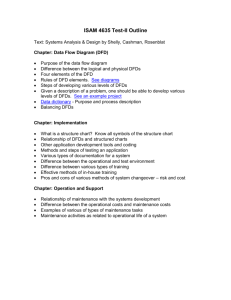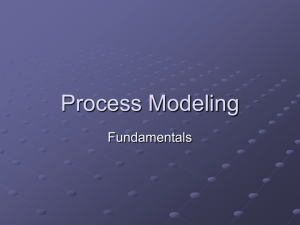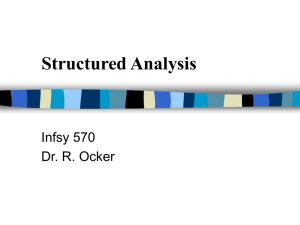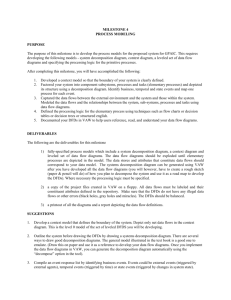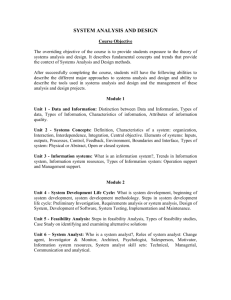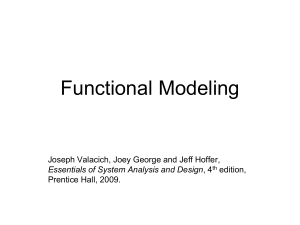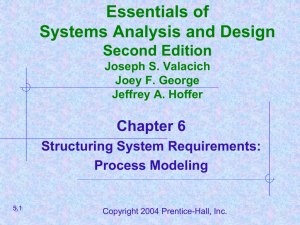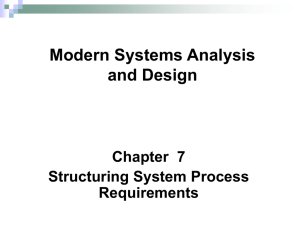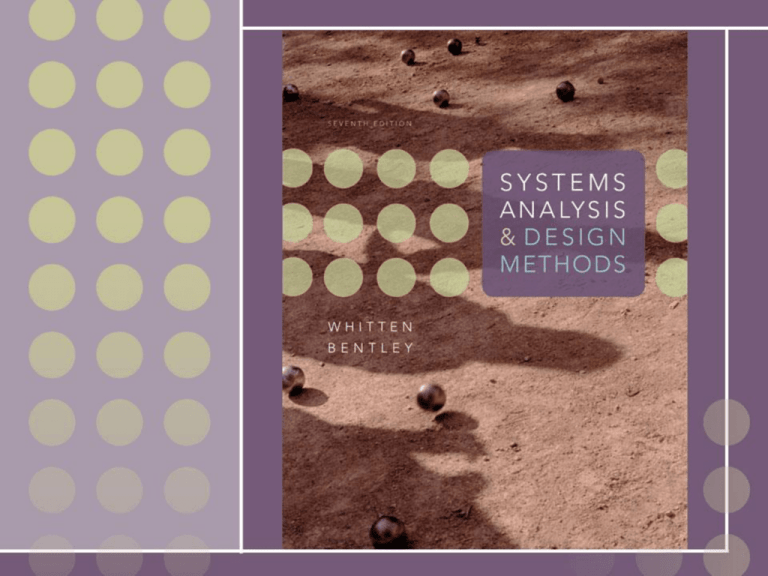
Chapter 9
Process Modeling
McGraw-Hill/Irwin
Copyright © 2007 by The McGraw-Hill Companies, Inc. All rights reserved.
Objectives
• Define systems modeling and differentiate logical and physical
models.
• Define process modeling and explain its benefits.
• Recognize and understand basic concepts and constructs of a
process model.
• Read and interpret a data flow diagram.
• Explain when to construct process models and where to store
them.
• Construct a context diagram to illustrate a system’s interfaces with
its environment.
• Identify use cases, external and temporal business events.
• Perform event partitioning and organize events in a functional
decomposition diagram.
• Draw event diagrams and merge them into a system diagram.
• Draw primitive data flow diagrams and describe the elementary
data flows in terms of data structures and procedural logic.
• Document the distribution of processes to locations.
• Synchronize data and process models using a CRUD matrix.
9-3
Models: Logical and Physical
Model – a pictorial representation of reality.
Just as a picture is worth a thousand words, most
models are pictorial representations of reality.
Logical model – a
nontechnical pictorial
representation that depicts
what a system is or does.
Synonyms or essential
model, conceptual model,
and business model.
9-4
Physical model – a
technical pictorial
representation that depicts
what a system is or does and
how the system is
implemented. Synonyms are
implementation model and
technical model.
Why Logical System Models
• Logical models remove biases that are the
result of the way the system is currently
implemented, or the way that any one person
thinks the system might be implemented.
• Logical models reduce the risk of missing
business requirements because we are too
preoccupied with technical results.
• Logical models allow us to communicate with
end-users in nontechnical or less technical
languages.
9-5
Process Modeling and DFDs
Process modeling – a technique used to organize and
document a system’s processes.
•
•
•
•
Flow of data through processes
Logic
Policies
Procedures
Data flow diagram (DFD) – a process model used to
depict the flow of data through a system and the work or
processing performed by the system. Synonyms are
bubble chart, transformation graph, and process model.
• The DFD has also become a popular tool for business
process redesign.
9-6
Simple Data Flow Diagram
9-7
Differences Between DFDs
and Flowcharts
• Processes on DFDs can operate in parallel (atthe-same-time)
• Processes on flowcharts execute one at a time
• DFDs show the flow of data through a system
• Flowcharts show the flow of control (sequence and
transfer of control)
• Processes on a DFD can have dramatically
different timing (daily, weekly, on demand)
• Processes on flowcharts are part of a single program
with consistent timing
9-8
External Agents
External agent – an outside person, unit,
system, or organization that interacts with a
system. Also called an external entity.
• External agents define the “boundary” or
scope of a system being modeled.
• As scope changes, external agents can
become processes, and vice versa.
• Almost always one of the following:
• Office, department, division.
• An external organization or agency.
• Another business or another
information system.
• One of system’s end-users or managers
9-9
• Named with descriptive, singular noun
Gane and Sarson shape
DeMarco/Yourdon shape
Data Stores
Data store – stored data intended for later
use. Synonyms are file and database.
• Frequently implemented as a file or database.
• A data store is “data at rest” compared to a data
flow that is “data in motion.”
• Almost always one of the following:
•
•
•
•
•
Persons (or groups of persons)
Places
Objects
Events (about which data is captured)
Concepts (about which data is important)
• Data stores depicted on a DFD store
all instances of data entities
(depicted on an ERD)
• Named with plural noun
9-10
Gane and Sarson shape
DeMarco/Yourdon shape
Process Concepts
Process – work performed by a system in
response to incoming data flows or
conditions. A synonym is transform.
• All information systems include
processes - usually many of them
• Processes respond to business
events and conditions and transform Gane and Sarson shape
data into useful information
• Modeling processes helps us to understand the
interactions with the system's environment, other
systems, and other processes.
• Named with a strong action verb followed by object
clause describing what the work is performed on/for .
9-11
The System is Itself a Process
9-12
Process Decomposition
Decomposition – the act of breaking a system
into sub-components. Each level of abstraction
reveals more or less detail.
9-13
Decomposition Diagrams
Decomposition
diagram – a tool
used to depict the
decomposition of a
system. Also
called hierarchy
chart.
9-14
Types of Logical Processes
Function – a set of related and ongoing activities of a
business.
• A function has no start or end.
Event – a logical unit of work that must be completed as
a whole. Sometimes called a transaction.
• Triggered by a discrete input and is completed when process
has responded with appropriate outputs.
• Functions consist of processes that respond to events.
Elementary process – a discrete, detailed activity or
task required to complete the response to an event.
Also called a primitive process.
• The lowest level of detail depicted in a process model.
9-15
Common Process Errors on
DFDs
9-16
Data Flows & Control Flows
Data flow – data that is input to or
output from a process.
• A data flow is data in motion
• A data flow may also be used to
represent the creation, reading, deletion,
or updating of data in a file or database
(called a data store).
Composite data flow – a data flow
that consists of other data flows.
Control flow – a condition or
nondata event that triggers a
process.
• Used sparingly on DFDs.
9-17
Data flow name
Control flow name
Data Flow Packet Concept
• Data that should travel together should be
shown as a single data flow, no matter how
many physical documents might be included.
9-18
Composite and Elementary
Data Flows
Composite
flow
Elementary
flows
9-19
Junction indicates that
any given order is an
instance of only one of
the order types.
Data Flows to and from Data
Stores
9-20
Rules for Data Flows
• A data flow
should never go
unnamed.
• In logical
modeling, data
flow names
should describe
the data flow
without
describing the
implementation
• All data flows
must begin
and/or end at a
process.
9-21
Data Conservation
Data conservation – the practice of
ensuring that a data flow contains only
data needed by the receiving process.
9-22
• Sometimes called starving the processes.
• New emphasis on business process
redesign to identify and eliminate
inefficiencies.
• Simplifies the interface between those
processes.
• Must precisely define the data composition
of each data flow, expressed in the form of
data structures.
Data Structures
Data attribute – the smallest piece of data that
has meaning to the users and the business.
Data structure – a specific arrangement of data
attributes that defines an instance of a data flow.
• The data attributes that comprise a data flow are
organized into data structures.
• Data flows can be described in terms of the following
types of data structures:
9-23
• A sequence or group of data attributes that occur one after
another.
• The selection of one or more attributes from a set of attributes.
• The repetition of one or more attributes.
Data Structure for a Data Flow
DATA STRUCTURE
ENGLISH ENTERPRETATION
ORDER=
ORDER NUMBER +
ORDER DATE+
[ PERSONAL CUSTOMER NUMBER,
CORPORATE ACCOUNT
NUMBER]+
SHIPPING ADDRESS=ADDRESS+
(BILLING ADDRESS=ADDRESS)+
1 {PRODUCT NUMBER+
PRODUCT DESCRIPTION+
QUANTITY ORDERED+
PRODUCT PRICE+
PRODUCT PRICE SOURCE+
EXTENDED PRICE } N+
SUM OF EXTENDED PRICES+
PREPAID AMOUNT+
(CREDIT CARD
NUMBER+EXPIRATION DATE)
(QUOTE NUMBER)
An instance of ORDER consists of:
ORDER NUMBER and
ORDER DATE and
Either PERSONAL CUSTOMER NUMBER
or CORPORATE ACCOUNT
NUMBER
and SHIPPING ADDRESS (which is
equivalent
to ADDRESS)
and optionally: BILLING ADDRESS
(which is
equivalent to
ADDRESS)
and one or more instances of:
PRODUCT NUMBER and
PRODUCT DESCRIPTION and
QUANTITY ORDERED and
PRODUCT PRICE and
PRODUCT PRICE SOURCE and
EXTENDED PRICE
and SUM OF EXTENDED PRICES and
PREPAID AMOUNT and
optionally: both CREDIT CARD NUMBER
and EXPIRATION DATE
ADDRESS=
(POST OFFICE BOX NUMBER)+
STREET ADDRESS+
CITY+
[STATE, MUNICIPALITY]+
(COUNTRY)+
9-24
POSTAL CODE
An instance of ADDRESS consists of:
optionally: POST OFFICE BOX NUMBER
and
STREET ADDRESS and
CITY and
Either STATE or MUNICIPALITY
and optionally: COUNTRY
and POSTAL CODE
Data Structure Constructs
Format by Example
(relevant portion is boldfaced
English Interpretation
(relevant portion is boldfaced)
Sequence of Attributes - The
WAGE AND TAX STATEMENT=
sequence data structure
TAXPAYER IDENTIFICATION
indicates one or more attributes NUMBER+
that may (or must) be included in
TAXPAYER NAME+
a data flow.
TAXPAYER ADDRESS+
WAGES, TIPS, AND
COMPENSATION+
FEDERAL TAX
WITHHELD+…
An instance of WAGE AND TAX
STATEMENTS consists of:
TAXPAYER IDENTIFICATION
NUMBER and
TAXPAYER NAME and
TAXPAYER ADDRESS and
WAGES, TIPS AND
COMPENSATION and
FEDERAL TAX WITHHELD
and…
Selection of Attributes - The
selection data structure allows
you to show situations where
different sets of attributes
describe different instances of
the data flow.
An instance or ORDER consists
of:
Either PERSONAL
CUSTOMER NUMBER or
CORPORATE
ACCOUNT NUMBER; and
ORDER DATE and…
Data Structure
9-25
ORDER=
(PERSONAL CUSTOMER
NUMBER,
CORPORATE ACCOUNT
NUMBER)+
ORDER DATE+…
Data Structure Constructs
(continued)
Data Structure
Format by Example
(relevant portion is boldfaced
Repetition of Attributes - The
POLICY NUMBER+
repetition data structure is used
POLICYHOLDER NAME+
to set off a data attribute or
POLICY HOLDER ADDRESS+
group of data attributes that may
0 {DEPENDENT NAME+
(or must) repeat themselves a
DEPENDENT’S
specific number of time for a
RELATIONSHIP} N+
single instance of the data flow.
1 {EXPENSE DESCRIPTION+
The minimum number of
SERVICE PROVIDER+
repetitions is usually zero or
EXPENSE AMOUNT} N
one.
The maximum number of
repetitions may be specified as
“n” meaning “many” where the
actual number of instances
varies for each instance of the
data flow.
9-26
English Interpretation
(relevant portion is boldfaced)
An instance of CLAIM consists
of:
POLICY NUMBER and
POLICYHOLDER NAME and
POLICYHOLDER ADDRESS
and
zero or more instance of:
DEPENDENT NAME and
DEPENDENT’S
RELATIONSHIP and
one or more instances of:
EXPENSE DESCRIPTION
and
SERVICE PROVIDER and
EXPENSE ACCOUNT
Data Structure Constructs
(concluded)
Data Structure
Optional Attributes - The
optional notation indicates that
an attribute, or group of
attributes in a sequence or
selection date structure may not
be included in all instances of a
data flow.
Note: For the repetition data
structure, a minimum of “zero” is
the same as making the entire
repeating group “optional.”
Reusable Attributes - For
groups of attributes that are
contained in many data flows, it
is desirable to create a separate
data structure that can be
reused in other data structures.
9-27
Format by Example
(relevant portion is boldfaced
CLAIM=
POLICY NUMBER+
POLICYHOLDER NAME+
POLICYHOLDER ADDRESS+
( SPOUSE NAME+
DATE OF BIRTH)+…
English Interpretation
(relevant portion is boldfaced)
An instance of CLAIM consists
of:
POLICY NUMBER and
POLICYHOLDER NAME and
POLICYHOLDER ADDRESS
and
optionally, SPOUSE NAME
and
DATE OF BIRTH and…
DATE=
MONTH+
DAY+
YEAR+
Then, the reusable structures
can be included in other data
flow structures as follows:
ORDER=ORDER
NUMBER…+DATE
INVOICE=INVOICE
NUMBER…+DATE
PAYMENT=CUSTOMER
NUMBER…+DATE
Data Types and Domains
Data attributes should be defined by data
types and domains.
Data type - a class of data that be stored
in an attribute.
• Character, integers, real numbers, dates,
pictures, etc.
Domain – the legitimate values for an
attribute.
9-28
Diverging and Converging
Data Flows
Diverging data flow – a data flow that splits
into multiple data flows.
• Indicates data that starts out naturally as one flow,
but is routed to different destinations.
• Also useful to indicate multiple copies of the same
output going to different destinations.
Converging data flow – the merger of multiple
data flows into a single packet.
• Indicates data from multiple sources that can (must)
come together as a single packet for subsequent
processing.
9-29
Diverging and Converging
Data Flows
9-30
When to Draw Process Models
• Strategic systems planning
• Enterprise process models illustrate important
business functions.
• Business process redesign
• “As is” process models facilitate critical analysis.
• “To be” process models facilitate improvement.
• Systems analysis (primary focus of this
course)
9-31
•
•
•
•
Model existing system including its limitations
Model target system’s logical requirements
Model candidate technical solutions
Model the target technical solution
Classical Structured Analysis
Rarely practiced anymore because cumbersome & time-consuming
9-32
1. Draw top-down physical DFDs that represent current
physical implementation of the system.
2. Convert physical DFDs to logical equivalents.
3. Draw top-down logical DFDs that represent improved
system.
4. Describe all data flows, data stores, policies, and
procedures in data dictionary or encyclopedia.
5. Optionally, mark up copies of the logical DFDs to
represent alternative physical solutions.
6. Draw top-down physical DFDs representing target
solution.
Modern Structured Analysis
(More Commonly Practiced)
1. Draw context DFD to establish initial project scope.
2. Draw functional decomposition diagram to partition the
system into subsystems.
3. Create event-response or use-case list for the system
to define events for which the system must have a
response.
4. Draw an event DFD (or event handler) for each event.
5. Merge event DFDs into a system diagram (or, for larger
systems, subsystem diagrams).
6. Draw detailed, primitive DFDs for the more complex
event handlers.
7. Document data flows and processes in data dictionary.
9-33
Structured Analysis Diagram
Progression (1 of 3)
9-34
Structured Analysis Diagram
Progression (2 of 3)
9-35
Structured Analysis Diagram
Progression (3 of 3)
9-36
CASE for Process Modeling
9-37
Context Data Flow Diagram
•
9-38
Context data flow diagram - a process model
used to document the scope for a system. Also
called the environmental model.
1. Think of the system as a "black box."
2. Ask users what business transactions the system
must respond to. These are inputs, and the sources
are external agents.
3. Ask users what responses must be produced by the
system. These are outputs, and the destinations are
external agents.
4. Identify any external data stores, if any.
5. Draw a context diagram.
SoundStage Context DFD
9-39
SoundStage Functional
Decomposition Diagram
• Break system into
sub-components
to reveal more
detail.
• Every process to
be factored
should be
factored into at
least two child
processes.
• Larger systems
might be factored
into subsystems
and functions.
9-40
Events and Use Cases
• External events are initiated by external agents. They
result in an input transaction or data flow.
• Temporal events are triggered on the basis of time, or
something that merely happens. They are indicated
by a control flow.
• State events trigger processes based on a system’s
change from one state or condition to another. They
are indicated by a control flow.
• Use case – an analysis tool for finding and identifying
business events and responses.
• Actor – anything that interacts with a system.
9-41
SoundStage Partial Use Case
List
Actor/
External Agent
Trigger
Marketing
Establishes a new
membership
subscription plan to
entice new members.
New Member
Subscription
Program
Marketing
Establishes a new
membership
resubscription plan to
lure back former
members.
A subscription plan
expires.
Past Member
Resubscription
Program
Joins club by
subscribing.
New
Subscription
(time)
Member
9-42
Event
(or Use Case)
(current date)
Response
Generate Subscription Plan
Confirmation.
Create Agreement in the
database.
Generate Subscription Plan
Confirmation.
Create Agreement in the
database.
Generate Agreement Change
Confirmation.
Logically delete Agreement in
database.
Generate Member Directory
Update Confirmation.
Create Member in database.
Create first Member Order and
Member Ordered Products in
database.
SoundStage Partial
Event Decomposition Diagram
9-43
Event Diagrams
Event diagram – data flow diagram that
depicts the context for a single event.
• One diagram for each event process
• Depicts
• Inputs from external agents
• Outputs to external agents
• Data stores from which records must be "read."
Data flows should be added and named to
reflect the data that is read.
• Data stores in which records must be created,
deleted, or updated. Data flows should be
named to reflect the update.
9-44
Simple Event Diagram
9-45
Event Diagram (more complex)
9-46
Temporal Event Diagram
9-47
System DFD
9-48
System DFD (concluded)
9-49
Balancing
Balancing - a concept that requires that
data flow diagrams at different levels of
detail reflect consistency and completeness
• Quality assurance technique
• Requires that if you explode a process to
another DFD to reveal more detail, you must
include the same dta flows and data stores
9-50
Primitive Diagrams
• Some (not necessarily all) event
processes may be exploded into primitive
diagrams to reveal more detail.
• Complex business transaction processes
• Process decomposed into multiple
elementary processes
• Each elementary process is cohesive - it
does only one thing
• Flow similar to computer program structure
9-51
Primitive DFD
(see book for more readable copy)
9-52
Specifying a Data Flow
Using a CASE Tool
9-53
Process Logic
• Data Flow Diagrams good for identifying and
describing processes
• Not good at showing logic inside processes
• Need to specify detailed instructions for
elementary processes
• How to do it?
• Flowcharts & Pseudocode - most end users do not
understand them
• Natural English - imprecise and subject to
interpretation
9-54
Problems with Natural English
• Many do not write well and do not question writing abilities.
• Many too educated to communicate with general audience
• Some write everything like it was a program.
• Can allow computing jargon, acronyms to dominate
language.
• Statements frequently have excessive or confusing scope.
• Overuse compound sentences.
• Too many words have multiple definitions.
• Too many statements use imprecise adjectives.
• Conditional instructions can be imprecise.
• Compound conditions tend to show up in natural English.
9-55
Source: Adapted from Matthies, Leslie, The New Playscript Procedure,
(Stamford, CT: Office Publications, Inc. 1977)
Structured English
Structured English – a language syntax
for specifying the logic of a process.
• Based on the relative strengths of structured
programming and natural English.
9-56
Structured English Constructs
(Part 1)
9-57
Structured English Constructs
(Part 2)
9-58
Structured English Restrictions
on Process Logic
9-59
• Only strong, imperative verbs may be used.
• Only names that have been defined in project
dictionary may be used.
• Formulas should be stated clearly using
appropriate mathematical notations.
• Undefined adjectives and adverbs are not
permitted.
• Blocking and indentation are used to set off the
beginning and ending of constructs.
• User readability should always take priority.
Policies and Decision Tables
Policy – a set of rules that govern show a
process is to be completed.
Decision table – a tabular form of
presentation that specifies a set of
conditions and their corresponding actions.
• As required to implement a policy.
9-60
A Simple Decision Table
9-61
Describing an Elementary
Process Using a CASE Tool
9-62
Data & Process Model
Synchronization CRUD Matrix
9-63
Process Distribution
9-64

